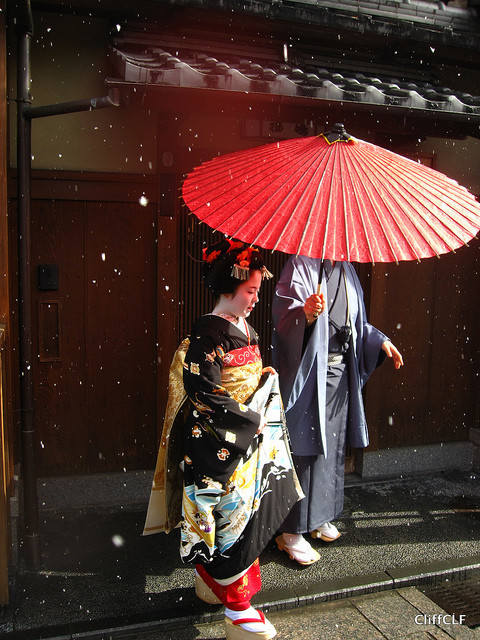Kimono Flea Market ICHIROYA's News Letter No.721

Hello, this is Mitsue writing. The air is getting cool and the leaves are turning red and yellow. Kyoto and Nara are so crowded with visitors to see autumn leaves. I planned to visit Nara next week, and Kyoto at the end of this month with my friends.
My teacher of erthu (2-stringed Chinese instrument played with a bow) lives in Kyoto, and she happened to see Maiko last week at Yasaka shrine. They attended fire prevention campaign and helped for passing out tissues for public to call out attention for beware of fire. My teacher says she doesn't see Maiko so often even if living in Kyoto. So, she might have screamed 'MAIKO Haaaaan!!!' in her mind. It is a title of a Japanese comedy movie! During day times, Maiko takes lessons to polish their performances. So, if you see Maiko during daytime, probably she is a tourist who dress like Maiko. There are Maiko transformation studios in Kyoto!


Maiko is an apprentice geiko (not exactly same as geisha). Their jobs consist of performing songs, dances, and playing the shamisen or the koto (traditional Japanese instruments) for visitors during supper. Maiko are usually aged 15 to 20 years old and become geiko after learning how to dance the traditional Kyomai dances, play the shamisen, and learning Kyo-kotoba (dialect of Kyoto), regardless of their origins.
At night, they go out to work. At high-quality Japanese-style restaurants or Japanese-style inn, they perform dances, songs, play the shamisen, and serve visitors with sake. Recently, their jobs have expanded to include visiting nursing institutions or hospitals. Some maiko are also dispatched overseas.
Maiko originated from women who served green tea and dango (Japanese dumpling made from rice flour) to people who visited the Kitano Tenmangu or Yasaka Shrine (these are the two of the famous shrines in Kyoto) at teahouses about 300 years ago. At first, women served only green tea and dango, but they gradually started to perform songs and dances for visitors.
The hair style of Maiko has various kinds of Nihon gami(Japanese traditional hairstyles) depending on rank, formality and occasion. They decorate their hairstyles with seasonal kanzashi (traditional hair ornaments). Maiko, unlike geiko, use their own hair and not wigs. They go to the nihongami hairdresser once a week which means that they have to sleep on a takamakura (wooden block with a pillow) in order to maintain it.
Maiko wear special kimono called Susohiki or Hikizuri. They are usually 200cm long, with a padded hem to create weight so it will trail beautifully on the floor. When she walk outside, she will hold the bottom up with her hands, or tie it so that it does not touch the ground. The sleeves are long like those of a furisode. The kimono has colorful and seasinal pattern. For formal occasions the maiko will wear black Susohiki with 5 family crests of Okiya (house which she belongs to).

The darari obi is a 6-7 meters long obi worn by maiko. Due to its length and weight an otokoshi-san (male dresser) is needed to tie it. At the end of the darari obi has a crest, so that every one can see which okiya the maiko belongs to. For formal occasions the maiko will wear gold obi.

I wish I could take a photo some day....(haha!)
ICHIROYA has some pieces which have been worn by Maiko or Geiko. Please tale a look! Thank you for reading.
Susohiki for Maiko
http://www.ichiroya.com/item/list2/386119/
http://www.ichiroya.com/item/list2/372325/
Susohiki
http://www.ichiroya.com/item/list2/380124/
http://www.ichiroya.com/item/list2/284148/
http://www.ichiroya.com/item/list2/288034/
http://www.ichiroya.com/item/list2/380748/
Han-eri(additional collar)
http://www.ichiroya.com/item/list2/329062/
http://www.ichiroya.com/item/list2/347697/
http://www.ichiroya.com/item/list2/310744/
Obi
http://www.ichiroya.com/item/list2/355639/
Juban
http://www.ichiroya.com/item/list2/371977/